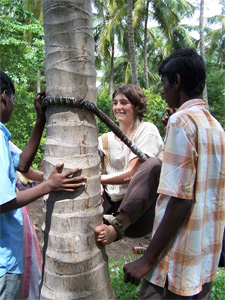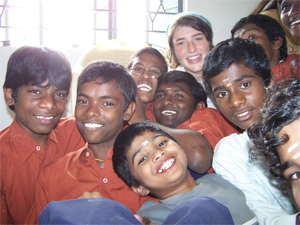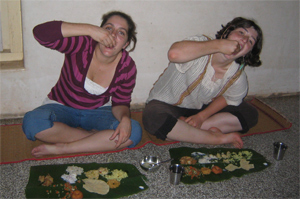Semester at Sea Fall
2006 Voyage 
- Home
Sweet Home
- And Now
Introducing...
- Multisited Ethnography Project
- A
Shipboard Interview
- Japan:
The Wisdom of a Soggy
Monk
- Hong
Kong: Looking for a Scam
- Vietnam:
Vietnamese Pie-Plate
to the Face
- Burma:
"Ok. Ok. No Problem." Androgyny in
Old Bagan
- India:
Traveler's Schizophrenia
- Egypt
vs. Turkey: Brains over
Beauty
- Croatia:
An Obscure
Conversation between an American Girl and a Croatian Forest
- Spain:
An Olive Offer Changed
My Life
- Open Letter
Traveler’s
Schizophrenia
Amy Dewitt
 I am a laidback
traveler. I shy away from itineraries
and large groups. I love spending the
moment in the moment instead of reflecting on the
moment that just passed and
then regretting. Flexibility is crucial,
positive attitude a must, and I take several leaps and bounds outside
of all
established comfort zones just to try something new. I travel
under the wings of the main concepts
of the Confucian communication model, searching for reciprocity always
with
gratitude to offer in return, avoiding confrontation and aggression,
and ready
to learn. I want to deserve the gifts of
culture; I want to be a dialectical traveler.
That does not make my mode of travel a cut above any other form; rather
it is a sieving process for all potential travel companions to go
through
before committing to traveling with me.
I may have forgotten to mention the word “ideally”: for the betterment
of the individual, it would ideally
weed out all travelers that do not share the same sentiments. It
does not.
As a result, I have diagnosed myself with a very serious case of
Wintrob’s
“disadaptation syndrome,” illustrated in Eric Haanstad’s meditation on
his
fieldwork on
I am a laidback
traveler. I shy away from itineraries
and large groups. I love spending the
moment in the moment instead of reflecting on the
moment that just passed and
then regretting. Flexibility is crucial,
positive attitude a must, and I take several leaps and bounds outside
of all
established comfort zones just to try something new. I travel
under the wings of the main concepts
of the Confucian communication model, searching for reciprocity always
with
gratitude to offer in return, avoiding confrontation and aggression,
and ready
to learn. I want to deserve the gifts of
culture; I want to be a dialectical traveler.
That does not make my mode of travel a cut above any other form; rather
it is a sieving process for all potential travel companions to go
through
before committing to traveling with me.
I may have forgotten to mention the word “ideally”: for the betterment
of the individual, it would ideally
weed out all travelers that do not share the same sentiments. It
does not.
As a result, I have diagnosed myself with a very serious case of
Wintrob’s
“disadaptation syndrome,” illustrated in Eric Haanstad’s meditation on
his
fieldwork on
 “I am quiet but
happy,” I claimed, “I’m just trying to soak in
“I am quiet but
happy,” I claimed, “I’m just trying to soak in
Prognosis:
I will continue to
cross paths with others
that do not share the same whimsical mentality that I carry when
traveling. Instead of extending such
whimsy to a positive, healthy interaction, I allow the noise to get in
the way
of intercultural communication and  understanding. The noise is
the most severe symptom of
traveler’s schizophrenia; sinking into internal seclusion and
irritability is a
resignation of cultural relativism. I
become “disadapted” and depersonalized “left to blindly inhabit secret
personal
worlds of discomfort and alienation.” But
as Haanstad continues to discover, “depersonalizing” oneself can be
useful. I learned a lot about Amy the
Traveler while in
understanding. The noise is
the most severe symptom of
traveler’s schizophrenia; sinking into internal seclusion and
irritability is a
resignation of cultural relativism. I
become “disadapted” and depersonalized “left to blindly inhabit secret
personal
worlds of discomfort and alienation.” But
as Haanstad continues to discover, “depersonalizing” oneself can be
useful. I learned a lot about Amy the
Traveler while in